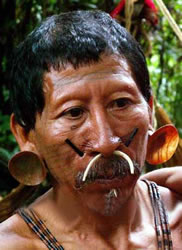THE MATIS
Apart from the fact that tattooing is a custom pleasing to the ancestors, the facial markings of Matis men have other symbolic functions especially when on the hunt. The Matis hunt with several varieties of weapons depending on the type of game they are after. Today, modern firearms are used but so too are the traditional bow and arrow for larger terrestrial animals including some species of monkeys that live in the jungle canopy. However, the most prestigious hunting weapon employed by the Matis is the blowgun, and on average it approaches some 12 feet in length making it one of the longest used in the entire Amazon.
The Matis are extremely fond of their palm wood blowguns because they are quiet and stealthy weapons. They require much more physical dexterity to operate than a bow, and they are also believed to house mariwin who dwell in palm groves planted by previous generations of Matis from which these arms are created. |
 |
Matis Elder Timu Prieto. Photograph © Dan James Pantone/www.MATSES.org |
Blowgun hunters never bring back as much meat as bowhunters, but this is not the purpose of the chase. Rather, blowgun hunters trek into the jungle in search of small monkeys for the teeth they bear. For amongst the Matis, necklaces and armbands made of particular species of small monkeys are the most highly-prized possessed any Matis individual can own, because one large necklace may hold over two hundred teeth. This translates into more than fifty kills which is no small accomplishment.
|
|
Blowgun hunters also differ from bowhunters in that they travel alone into the forest rather than setting off in a group. Moreover these solo huntsmen, unlike the bowmen, are completely adorned with black spots of body paint, teeth-like labrets made of blowgun darts, and whisker-like facial tattoos that are all symbols of the jaguar. The mariwin are also believed to sport these kinds of personal ornaments - although in far greater quantities - and in this way the dead are able to identify with the living during the hunt. Taken together, Matis blowgunners "dress to kill" by ultimately transforming themselves into the top predators of their jungle domain through deeply spiritual acts of body modification that were considered to be nothing less than a purely mythical and potent male pursuit. |
Literature
Colitt, R. (2007). "Forgotten Indians On Other Side of Brazil Farm Boom." Reuters (May 7): www.reuters.com/article/idUSN07348071
Erikson, P. (1990) "Near Beer of the Amazon." Natural History 8(90): 52-61.
-(1999). El Sello de Los Antepasados: Marcado del cuerpo y demarcación étnica entre los Matis de la Amazonia. Quito: Abya-Yala.
-(2001). "Myth and Material Culture: Matis Blowguns, Palm Trees, and Ancestor Spirits." Pp. 101-121 in Beyond the Visible and the Material: The Amerindianization of Society in the Work of Peter Rivière (L. Rival and N. Whitehead, eds.). Oxford: Oxford University Press.
Florence, H. (1941). Viagem fluvial do Tietê ao Amazonas de 1825 a 1829. São Paulo: Ediçðes Melhoramentos.
Grünberg, G. (2004). Os Kaiabi do Brasil Central: História e Etnografia. São Paulo: Instituto Socioambiental.
Nimuendajú, C. (1948). “The Cayabi, Tapanyuna, and Apiaca.” Pp. 307-320 in Handbook of South American Indians, v. 3, The Tropical Forest Tribes. Washington.
Oakdale, S. (2005). I Foresee My Life: The Ritual Performance of Autobiography in an Amazonian Community. Lincoln: University of Nebraska Press.
Ooko, S.A. (2008). "Amazon Forest Logging Sucks Peru and Brazil Into Fight Over Uprooted Indian Tribes." The Americas (October 20):
ecolocalizer.com/2008/10/20/amazon-forest-logging-sucks-peru-and-brazil-into-fight-over-uprooted-indian-tribes/
Romanoff, S., D.M.J. Huanán, F.S.U. Bëso, D.W. Flick (2004). Matsesën Nampid Chuibanaid: La Vida Tradicional de los Matsés. Lima: CAAAP.
Schmidt, M. (1942). “Los Kayabís en Matto-Grosso (Brazil).” Revista de la Sociedad Científica del Paraguay 5(6): 1-34.
Wallace, A. (2003). "Into the Amazon." National Geographic Magazine 204(2): 2-27.
Zaitchik, A. (2009). "Forest Fighters: Developers Tearing Down the Peruvian Amazon Have a New Enemy." The New Republic (April 24): www.tnr.com/article/politics/forest-fighters
First Page | 1
|
2 |
3 |
4 |
5 |
6 |
7 |
8 |
Museum photo gallery of the images
on this page may be seen here. |

